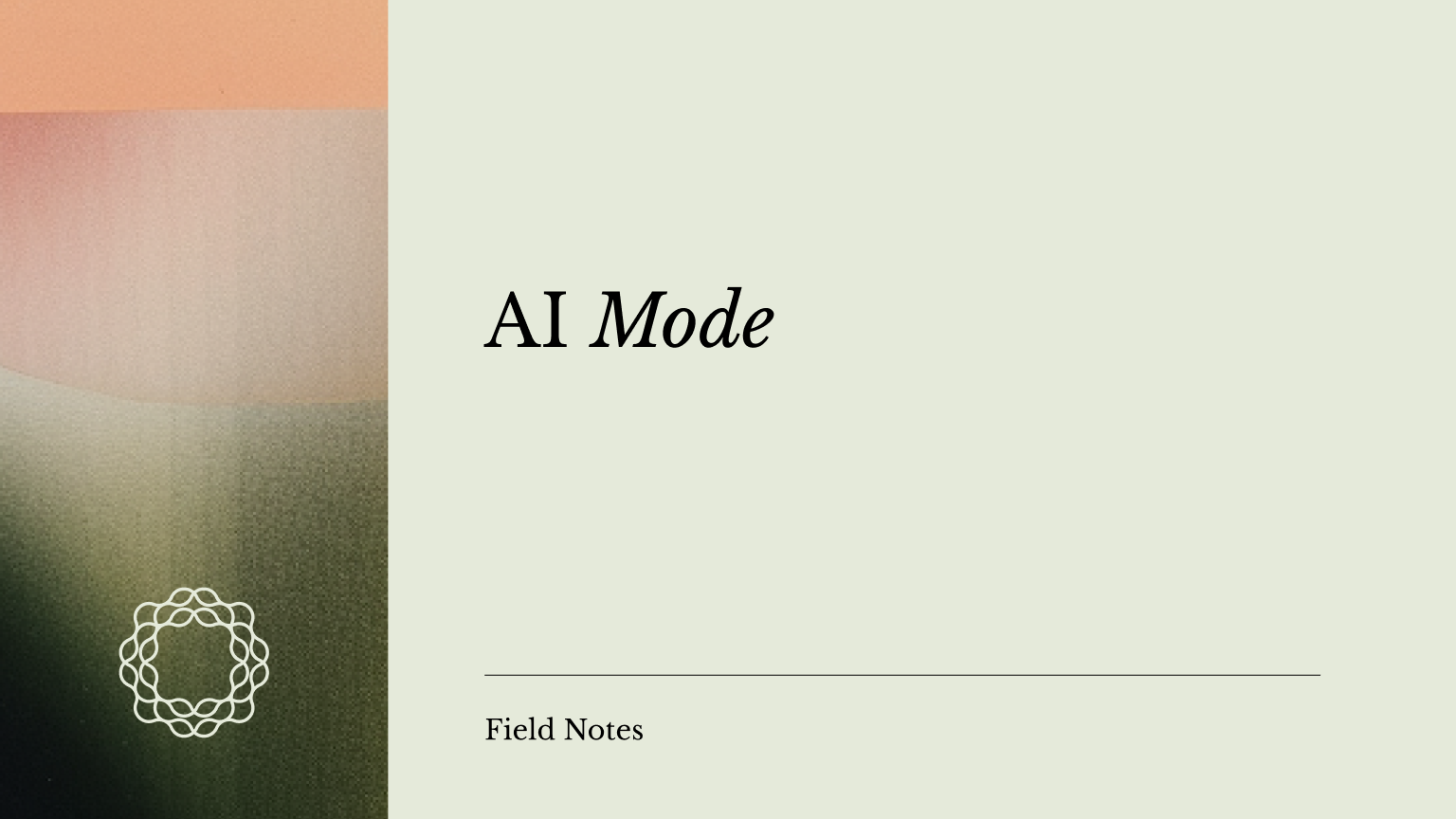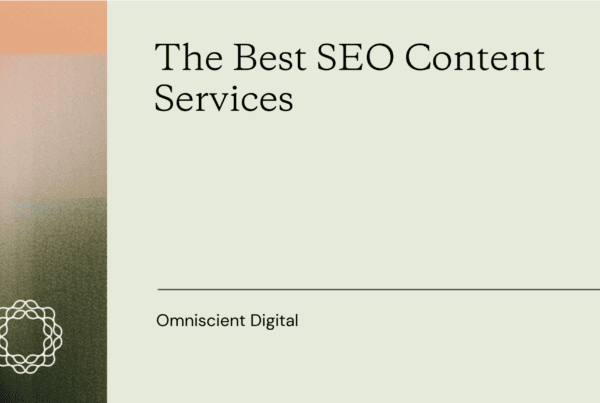
To our clients, partners, and friends:
At Google I/O 2025, among many other AI-centric updates, Google introduced AI Mode, a fully conversational search experience powered by Gemini 2.5 Pro. This new interface delivers chat-like, comprehensive answers, can interpret and synthesize data from Gmail and Google Calendar, and allows for natural follow-up questions — all within the search experience.
Most notably, it can autonomously perform actions such as booking tickets or making purchases via Google Pay.
AI Mode is now rolling out to U.S. users, signaling a fundamental redefinition of how search works and how users interact with content.
Here’s what’s changing, and what it actually means:
1. AI Overviews will now be everywhere (search gets Gemini native)
AI Overviews are no longer a side feature. They are quickly becoming the default experience for search.
- Users no longer see a list of 10 links
- Instead, they get instant, synthesized answers that take up above-the-fold real estate
- The data so far on AI overviews is mixed, but the story seems to be higher impressions yet fewer clicks to websites, though possibly more visibility to homepages and high-value product and use case pages
- Attribution is more difficult, especially up-funnel and pre-click metrics
What does this mean? Organic visibility now hinges on whether your content influences AI, not just whether it’s ranking. Classic search rankings, to be nuanced, still matter and correlate strongly with AI overview inclusions. Thus, strong search foundations, from a strategic layer, still matter. However, the goal is to expand from ranking (position 1-3) to being a credible source, cited and summarized by AI answers. Page Zero is the new page one.
2. Search becomes a chat interface with AI Mode (similar to ChatGPT, Perplexity, etc.)
Google is becoming a native LLM product, not just a navigational tool to find static documents or web pages. Search behavior is shifting from transactional or navigational to conversational. Searchers now:
- Ask a question
- Refine it
- Explore multiple turns and prompt iteration without leaving the interface and clicking through to a website or blog post
What does this mean? Static content strategies based on one-and-done keyword queries will fall short. Your content must persist through multi-turn, contextual dialogue. Comprehensive customer journey coverage, understanding of ICP pain points and buying criteria, and mapping to content and web navigation are increasingly important.
3. Multimodal Search: “Search Live” is here
Search is expanding beyond text. You can now point your camera at a product, ask complex questions about it, and receive intelligent answers in real time.
- Vision, context, and intent are now part of the query
- Search inputs are multimodal; the old SEO playbook is unprepared for this
What does this mean? SEOs must start thinking beyond metadata and blog posts. Product feeds, visual context, and real-world interaction now matter. The surface area of “search” has grown. The real world SEO implications of this for the majority of B2B products is TBD.
4. Project Astra: AI, everywhere (even inside your G-drive)
Google’s Project Astra is its assistant layer — a real-time, memory-aware, context-rich companion that works across your apps, from Gmail to Drive.
What does this mean? Expect Google’s AI to become ambient — helping users recall, summarize, and act across their digital footprint. Search becomes personalized infrastructure. Brand visibility must extend beyond your own website.
A quick note from the Omniscient team:
This moment in search and marketing is an inflection point. Between Google’s AI Mode, the rise of LLMs, and the crumbling clarity of analytics, we’re in a weird, wonderful era where the rules are changing fast (and often without notice).
We’d be lying if we said it wasn’t overwhelming at times. The pace of releases, the pressure to form opinions in real time, the gaps in attribution — none of it makes our jobs easier. But underneath the noise is something exciting: a wide-open opportunity to rethink how we create value, measure performance, and influence buyers.
This might be the closest we get to understanding what early SEOs felt like. There’s ambiguity, sure, but also a real sense of creative freedom. We’re not just publishing blog posts and waiting for traffic to trickle in; we’re shaping how people and machines understand brands in a fast evolving landscape built on top of a new and exciting technology.
So, we’re embracing the mess. We’re experimenting more, stressing less, and staying close to what matters: our clients, their customers, and the data that’s still within reach. It’s the new frontier of organic growth, and we’re glad to be navigating it together. We hope you feel the same.
Now, what should you do about these changes?
1. Let the dust settle
This is big, but don’t panic.
We’re seeing a lot of motion, but not all of it means immediate displacement. Some elements of search behavior have remained remarkably stable through a decade of updates.
- AI Mode is rolling out, but adoption curves are unpredictable. It’s yet to be determined how much AI Mode replaces versus augments and adds to traditional search and information retrieval. Likely, there is some overlap in utility, but the pie may also expand, representing more opportunities for organic acquisition
- We don’t yet know how engagement, visibility, or tracking will evolve
- What we do have: early patterns, experimental data, and first principles
Implication: Stay focused on generating unique value and addressing undermet needs for your customer base and prospective buyers. Resist shiny-object syndrome, or at the far end of the spectrum, getting titled and losing sight of the value you’ve already built. The pace is fast — but signal, not noise, will define strategic winners.
2. Understand that measurement and attribution is getting harder
Ironically perhaps, the ability to collect, organize, and make sense of customer acquisition data is becoming harder and harder, especially at the channel level:
- AI Mode, upon rollout, stripped referral parameters. GA4 reported it as “Direct.” This has since been fixed, though it is bucketed similarly to regular Google search traffic.
- Clicks from AI Overviews often don’t appear in Google Search Console
- Prompt-based queries replace keywords — and prompts (volume, intent, structure) aren’t measurable (yet)
Implication: We’ve entered an era where organic performance is less visible by default. This is a continuation of what was likely the actual reality of customer acquisition – namely, that a lot of influence came from “dark” or untrackable touchpoints. That doesn’t mean it’s not working — just that clicks are no longer the sole signal of success. Performance still shows up in incremental revenue, self-reported attribution, and in the visibility layer (i.e. understanding how your brand appears in LLM surface areas)
This is a continuation of a long arc: from zero-click searches, to snippets, to AI Overviews, and now AI Mode.
3. Accept that influence > clicks
We’ve long argued that traffic for traffic’s sake is a vanity metric (a.k.a. the Traffic Trap) — especially when that traffic is built on undifferentiated, reproducible content.
Now, that thesis is playing out in real-time:
- ChatGPT and Gemini generate boilerplate content in seconds
- Users prefer quick answers, not long blogs
- Summary-first search reduces scroll depth and link interaction
Implication: Your strategy can’t depend on getting users to click. We’re moving further into the zero-click era.
Your content must now be:
- Extractable. Is it structured so AI can parse and use it?
- Context-rich. Is it based on deep ICP knowledge and voice-of-customer phrasing? (E-E-A-T prevails for LLM optimization, too.)
- Ubiquitous. Is your brand mentioned across third-party sites, listings, and social signals?
This is where Surround Sound SEO becomes mission-critical. The battleground isn’t just the SERP — it’s everywhere the AI pulls data from.
This entails thinking beyond SEO, collaborating with product marketing, brand marketing, and digital PR teams to ensure consistent, expansive, and accurate brand coverage across influential surface areas.
4. Build on great foundations; aim at revenue growth
We’re optimistic because this new environment rewards signal over noise.
What doesn’t work:
- Churn-and-burn content
- Arbitrage hacks
- Ranking for keywords that don’t map to people, product, or pipeline
What does work:
- Credible, customer-first content that reflects deep understanding
- Off-page authority: brand mentions, expert quotes, earned visibility
- Structurally sound sites with clean UX, accessibility, navigability, and dialed in technical SEO
- A renewed focus on bottom-of-funnel growth, product positioning, customer journey coverage, and revenue contribution
We’ve built Omniscient Digital around these values from day one — and our clients have seen long-term gains, even when this meant choosing hard, high-relevance topics over easy wins.
Operating Principles for Organic Growth in the AI Era
We’ve already embedded GEO into everything we do. It’s not a bolt-on or a bandwagon. It’s a natural evolution of our customer-first, performance-driven content strategy.
Here’s what that looks like in practice:
1. Running experiments across models, formats, and visibility layers
- Reverse-engineering prompt chains and citation patterns in ChatGPT, Claude, Perplexity, and Gemini using first party data.
- Identifying which content types and structures are most often cited
- Testing prompt-aligned headers and summaries for higher LLM recall
- Using tools like Peec to spot where clients appear (or don’t) across LLMs
2. Updating our content briefs and workflows
Every piece of content now includes:
- LLM prompt targets: the questions we want to help answer
- Header alignment: natural phrasing and conversational triggers
- Summary blurbs: for quick citation and summarization
- FAQ blocks: to support both LLMs and “People Also Ask” boxes
- Structured elements: tables, lists, comparisons—easy for models to parse
- Internal link plans: to reinforce topic authority and semantic structure
3. Improving brand positioning and sentiment in LLMs
- Auditing citations and refining how clients are described in third-party content
- Rewriting high-traffic or frequently cited pages to reinforce brand messaging
- Doing manual outreach to clean up outdated or low-quality mentions
- Collaborating with product and brand teams to align language across channels
4. Staying grounded in first principles
- Voice of customer comes first. Always has, always will.
- Search is still about problem-solving. Only now, the “search” is happening everywhere.
- Content is still a valuable asset. But reach, resonance, and recall (not just clicks) are the metrics that matter.
We’re not chasing hacks. We’re building systems that scale, and the core of our work remains unchanged.
Want more insights like this? Subscribe to our Field Notes.


